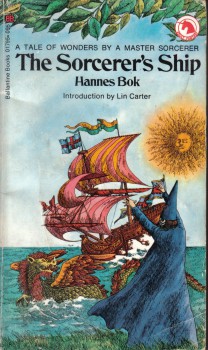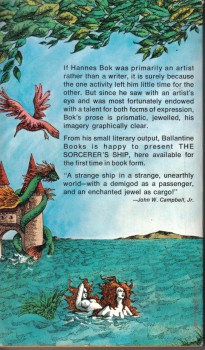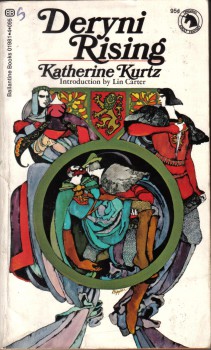The Ballantine Adult Fantasy Series: The Sorcerer’s Ship by Hannes Bok
 The Sorcerer’s Ship
The Sorcerer’s Ship
Hannes Bok
Ballantine, 205 p., December 1969, $0.95
Cover Art by Ray Cruz
First, I’d like to apologize to John and everyone else who reads these posts for taking so long to get this one done. I was on the road quite a bit from the end of May up through the Fourth, but I thought I would be able to get this particular post done quickly. Then things started happening. Car repairs, then house repairs, and then more car repairs. (This has necessitated bank account repairs.) Then last night, one of the wires in my son’s braces snapped loose. If anything else happens, I’m going to snap.
I don’t mean to kvetch. As you can see, I’ve been a bit distracted and apologize for the delay. I’ve already started the next book I’ll read for this series.
Anyway, on to something a little different than what we’ve seen in the Ballantine Adult Fantasy series up to this point. Rather than something deep and complex, with complicated writing (The Wood Beyond the World) or bizarre imagery (Lilith) or even not-so-subtle innuendo (The Silver Stallion), The Sorcerer’s Ship is almost a children’s story.
It’s not intended to be, but this is one that might hold a younger person’s interest. There’s certainly nothing in it that most parents would find objectionable for a child capable of reading a book of this length.
Hannes Bok is best remembered for his art, but as Lin Carter discusses in his introduction, Bok was also a more than capable writer. Carter chose this volume and The Golden Stair for inclusion in the BAF line. The Sorcerer’s Ship was originally published by John Campbell (not the world’s easiest sell by any means) in Unknown in December 1942. After Weird Tales, Unknown is arguably the greatest fantasy pulp in the history of the field.

The story starts out with a young man waking up on a raft out in the middle of the ocean. He has no memory of how he got there, or even of who he is. Eventually, his memory will return, and he’ll recall his name is Gene.
About sundown, Gene is rescued by a passing ship. The ship is on a secret mission carrying the princess of the kingdom of Nanich, Siwara, and her advisor Kaspel. The ship is captained by a coarse man named Froar. They are going to negotiate with the nation of Koph in an attempt to avoid war.
Siwara is young and comely. Kaspel, not so much. Froar not at all.
Koph is an aggressive nation where a few strong rule of a large population of poor, uneducated laborers. Nanich is just the opposite. The people there are educated and prosperous.
Siwara has been pursuing a policy of appeasement and hopes this mission, in which she plans to make concessions, will satisfy Koph. (I wonder if Neville Chamberlain was on Bok’s mind when he wrote this. There are some statements early on that are overtly political in nature.) Kaspel thinks this is a mistake and will do whatever he can to prevent Siwara from signing any treaty that weakens Nanich, including killing Siwara if that’s what it takes.
Froar secretly favors Koph and is planning on using Siwara as a hostage once the ship gets to Koph. He’s also willing to kill. He eventually kills Kaspel and makes several attempts on Gene’s life.
 Gene finds himself a pawn in this intrigue, although he will assert himself well before the end. Kaspel tries to convince Gene that if he can get Siwara to fall in love with him, then they can prevent Nanich from becoming a vassal state of Koph.
Gene finds himself a pawn in this intrigue, although he will assert himself well before the end. Kaspel tries to convince Gene that if he can get Siwara to fall in love with him, then they can prevent Nanich from becoming a vassal state of Koph.
Much of the middle portion of the book involves Froar making several attempts on Gene’s life. I found the unwillingness of Kaspel and Gene to put a definite stop to this behavior one of the weaknesses of the novel. But then, if they had acted against Froar when they should have, there would have been no novel, just a novella.
Eventually the ship is blown off course during a storm and finds an island that isn’t on the charts. A group of sailors go ashore and return with tales of a fabulous city containing an altar that has been used for sacrifice. They also bring back a little clay doll that they claim was alive until they picked it up.
The next day Siwara, Froar, Kaspel, and Gene go ashore. There they find the source of the dolls, a sorcerer named Yanuk. Gene and the others have been able to understand each other, even though they don’t speak the same language. Bok made a clear effort to explain this, invoking something along the lines of telepathy. When they meet Yanuk, only Gene can understand him. The others can’t make any sense out of what he says. This detail is conveniently ignored later.
It turns out that Yanuk is the last surviving member of his race. He is a servant of Orcher, a being powerful enough that Siwara refers to him as a god more than once, something Orcher denies being. Gene is in this world as a side effect of Orcher’s activities.
Before the group can summon Orcher and request his aid, Froar kills Kaspel. When Orcher appears, he isn’t happy about being interrupted at whatever it is he’s doing. He says none of them can understand it, but he is willing to aid them once. He gives them a heavy jewel and tells them to break at their moment of greatest need.
Accompanied by Yanuk, the group returns to the ship. Froar gloats that a war fleet from Koph is on its way to Nanich. Siwara, Gene, and Yanuk attempt to outrun the fleet.
I’ll leave off the summary at this point rather than give away the ending. I enjoyed The Sorcerer’s Ship, but I can understand why it’s not that well remembered today. The writing isn’t bad, and in fact is easier reading than some of the other BAF titles that preceded it. The problem is the story really isn’t a novel length story.
For starters, the shenanigans Froar tries to pull get a little tired and start to feel like padding. That’s not entirely surprising considering that Bok was writing for a market that paid by the word.
My biggest gripe though, is that the characters didn’t really have much depth and the two countries were never painted in more than just broad strokes. The characters were fairly flat. Siwara fell in love with Gene far too easily. Several times she switches from princess to scared young women and back instantaneously.
 If this had been a middle grade or YA novel aimed at the younger end of the YA spectrum, the lack of depth would be fine. It falls a little short of what I’ve come to expect of an adult novel. In terms of the contemporary market, which I realize Bok wasn’t writing for, this would be a solid first draft that needs some fleshing out in terms of character and world building.
If this had been a middle grade or YA novel aimed at the younger end of the YA spectrum, the lack of depth would be fine. It falls a little short of what I’ve come to expect of an adult novel. In terms of the contemporary market, which I realize Bok wasn’t writing for, this would be a solid first draft that needs some fleshing out in terms of character and world building.
Like I said, I enjoyed this book and would be willing to read it again in spite of what I see are some flaws. Carter gives it high praise in his introduction. I’m not sure how much his close friendship with Hannes Bok colored his perceptions here. However, to be fair, my taste and Carter’s might simply diverge here.
I’m going to skip ahead in the sequence of BAF titles for the next post. There was a recent post by Derek Kunsken about Kathryn Krutz’s Deryni novels. This series got its start in the BAF line. So the next book I look at will be Deryni Rising. Join me, won’t you?
Previous posts in this series are:
Lin Carter and the Ballantine Adult Fantasy Series
The Blue Star by Fletcher Pratt
The King of Elfland’s Daughter by Lord Dunsany
The Wood Beyond the World by William Morris
Lilith by George MacDonald
The Silver Stallion by James Branch Cabell
Keith West blogs way more than any sane person should. His main blog is Adventures Fantastic, which focuses on fantasy and historic fiction.
You know, I’m just going to come right out and say thank you for posting the name of the cover artist in your review. Well done!
Welcome back! I’ve been wondering where the BAF posts wandered off to.
I’ve slowly been collecting these BAF books and have about half of them now. I’ll try to get my hands on the Kurtz volumes before you post again.
Look forward to seeing more BAF posts!
It’s definitely more accessible than many of the other BAF books, but it’s also definitely Bok riffing on A. Merritt’s Ship of Ishtar. Regardless, I’m glad Carter rescued it from obscurity.
I’ve had a nice copy of this sitting on my shelf for several years; I’m definitely going to have to get to it soon. The most magical thing about it, though, has to be that cover price…
I’ve had a used copy of this book since 25 Feb. 1976, and no prospect of reading it at last any time soon…
Scott, you’re welcome. I’ll always include the full name of the cover artist in these posts. The cover art was such an integral part of the BAF line that to do otherwise would be criminal.
James, thank you. It’s good to be back. The Kurtz volumes should be easy to find since they were in print for years and went through multiple editions. Fletcher posted covers on his blog last week: http://swordssorcery.blogspot.com/2014/07/beautiful-covers-of-series-ive-never.html
I’m about halfway through Deryni Rising and loving it. I’m going to try to get the post in by the middle of next week (give or take a day). When it runs will be up to John, of course.
Joe, Lin Carter talks about Merritt’s influence on Bok and mentions The Ship of Ishtar in the introduction.
Thomas, unfortunately that cover price is no longer valid. 🙁
Major, that sounds like some of the titles in my library.
For Merritt, I’m torn whether I prefer Bok or Finlay as an illustrator. Really, it’s hard to go wrong with either …
Joe, agreed. Both were fantastic illustrators.
[…] posts over at Black Gate. The first, which went live a few weeks ago, was over Hannes Bok’s The Sorcerer’s Ship. The one that went live today was over Deryni Rising by Katherine […]
[…] Adult Fantasy Series Lilith by George MacDonald The Silver Stallion by James Branch Cabell The Sorcerer’s Ship by Hannes Bok Deryni Rising by Katherine Kurtz Land of Unreason by Fletcher Pratt and L. Sprague de Camp The […]